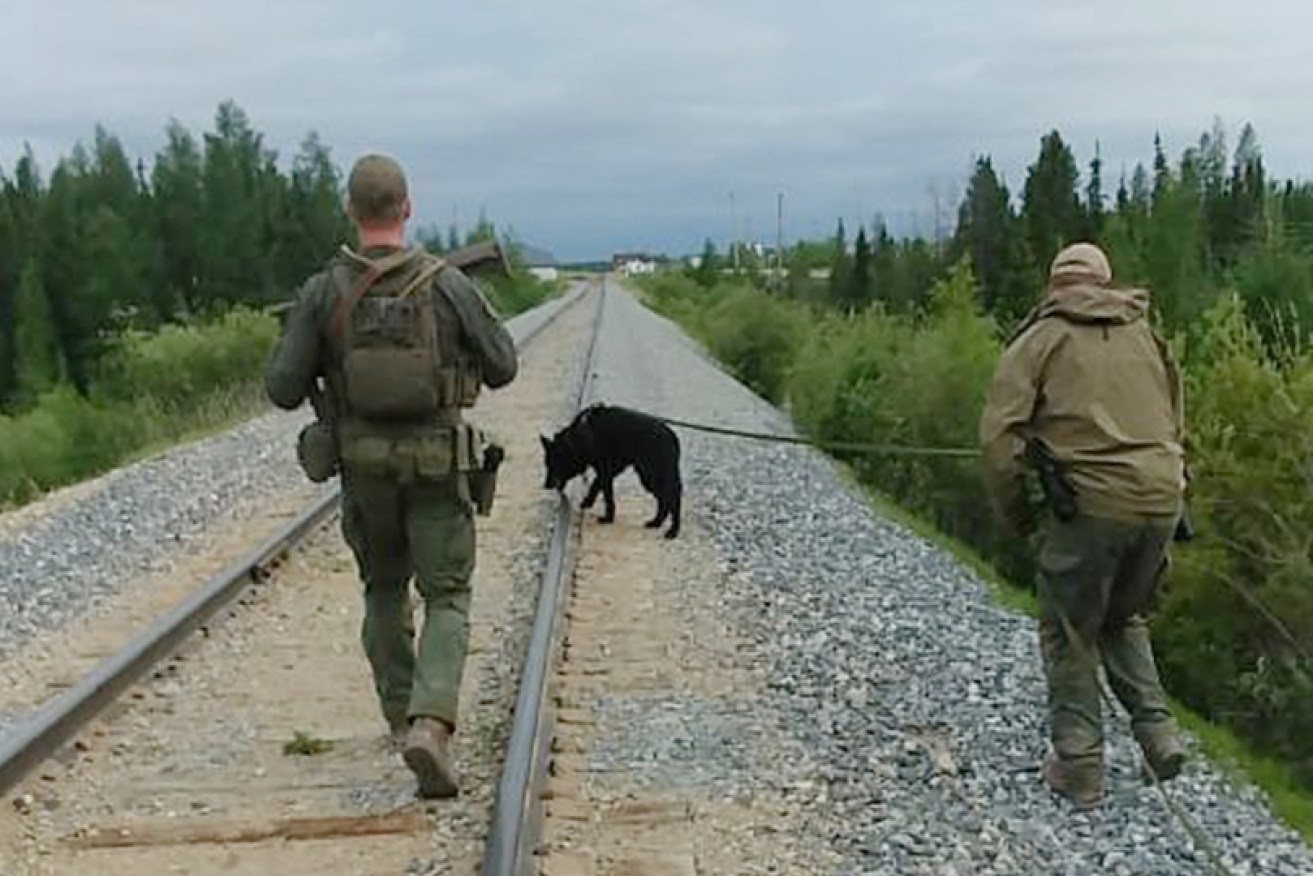Fugitive teens apparently spotted in Ontario


An intense manhunt has focused on remote northern Manitoba for a week. But the teenagers have not been sighted. Photo: AAP
A road worker in the Canadian province of Ontario has told police he believes he spotted the teen fugitives wanted over the unsolved killings of an Australian man and two others.
Police have been inundated with calls of possible sightings of Kam McLeod, 18, and Bryer Schmegelsky, 19, but have stressed that none of the reports have been substantiated by their own investigators.
According to local media, the latest sightings include three in north-eastern Ontario: one near Iron Bridge in Coulombe, and another on a highway in Kapuskasing. They are about 2300 kilometres away from the last confirmed sightings of the wanted pair, in remote northern Manitoba.
CBC reported Ontario police had received a report about a suspicious white vehicle driven through a construction zone on Highway 11 in Kapuskasing about 10.30am on Wednesday (local time).
OPP Constable Michelle Coulomb said a road worker on a highway construction team told police two men in a car had “similar descriptions” to the wanted teens.
“All our frontline members and resources conducted a search of that area with negative results,” Constable Coulomb said.

Bryer Schmegelsky (left) and Kam McLeod are said to have been spotted in Ontario.
The witness described the car, but didn’t get its number plate. Police are looking for the vehicle, and investigating other tips from the public.
It came as the Royal Canadian Mounted Police scaled back their exhaustive search 2300 kilometres away, at Gillam and York Landing in Manitoba. They said they had “done everything” they could in the area and were no closer to finding the fugitives, despite a huge week-long military and police sweep.
In coming days, the RCMP will begin pulling out of Gillam, where it has door-knocked every building.
After eight days of no official sightings of McLeod and Schmegelsky, police have raised the possibility the duo are dead. They are also considering the likelihood that the teenagers had some sort of help to flee the area.
“To be clear, we’re not ending the search,” Canada’s chief Mountie, assistant commissioner Jane MacLatchy, said.
“Tactical resources and specialised assets will remain positioned in the Gillam area and will continue with the efforts to locate the murder suspects.
“In addition, all of our resources will be ready to respond to the region as required should new information emerge.”
A massive contingent of police personnel, including sniffer dogs, was assisted by Royal Canadian Air Force planes equipped with infra-red cameras and imaging radar to search 11,000 square kilometres of town and wilderness.

Victims: Chynna Deese, Lucas Fowler and Leonard Dyck.
More than 500 homes and buildings were canvassed and train tracks, trails and other locations were searched. There were no confirmed sightings.
“I know that today’s news is not what the families of the victims and the communities of northern Manitoba wanted to hear,” assistant commissioner MacLatchy said.
“But when searching for people in vast remote and rugged locations, it’s always a possibility that they’re not going to be immediately located.”
“We canvassed every home and searched every abandoned building in Gillam and Fox Lake Cree Nation. This equals to over 500 homes and buildings.
“We searched rail lines, hydro corridors, lakes, rivers, vast areas of tundra and muskeg, dense forests and brush.
“We conducted exhaustive searches on foot, with dogs and with all-terrain vehicles. We used boats on lakes and searched from the air with drones, helicopters and planes.
“We used some of the most advanced technologies available and received assistance from some of the most highly skilled search and rescue personnel in the country.
“In addition, over 250 tips were received and followed-up on.
“However, even with this extraordinary effort, we have not had any confirmed sightings of the suspects since the burned vehicle was located.”
McLeod and Schmegelsky are suspected of killing Australian backpacker Lucas Fowler, his US girlfriend and a Vancouver botanist in a killing spree in British Columbia.
The teenagers are then alleged to have driven 3000 kilometres east across Canada to Gillam, where on July 23, they dumped and then set fire to their car.
Along the way they had peaceful encounters with a petrol station attendant, an indigenous officer on a alcohol checkpoint and a man who helped them after their vehicle became stuck in mud.
None realised at the time that McLeod and Schmegelsky were fugitives.

Sniffers dogs were used as part of the search for two suspected killers.
Assistant Commissioner MacLatchy denied the RCMP in Manitoba took too long to inform the public of its suspicions about the teenagers. She said the public was alerted via social media within an hour of the Mounties learning they might be in Manitoba.
Survival experts and Gillam locals said if the paid tried to hide in the wilderness without appropriate gear or shelter in the swampy sub-Arctic boreal forest, they would likely die from blood-sucking insects, tainted water, starvation, bears and other predators.
RCMP search teams had dogs trying to find their suspects’ scent but assistant commissioner MacLatchy said she was not sure if the dogs were trained to find dead bodies.
“It’s just a very tough place to find somebody who doesn’t want to be found,” she said.
McLeod and Schmegelsky have previously been described by family members as “good kids” who quit Walmart jobs on Vancouver Island to drive north to the Yukon to find work.
-with AAP








